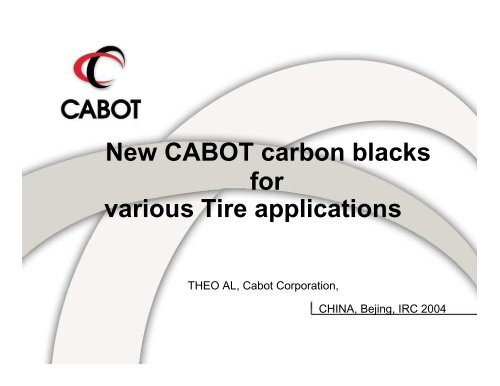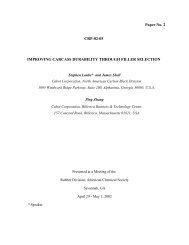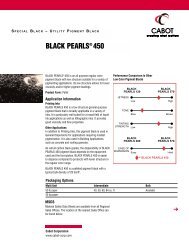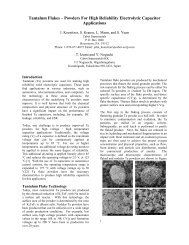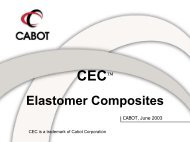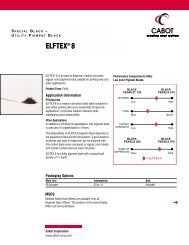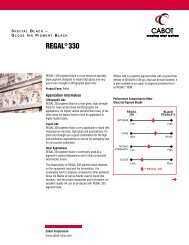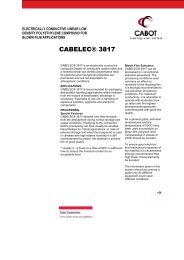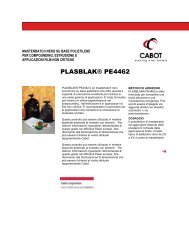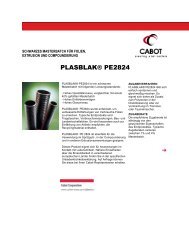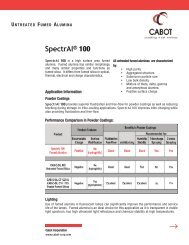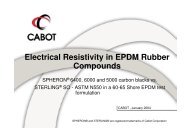vulcan 1436 - Cabot Corporation
vulcan 1436 - Cabot Corporation
vulcan 1436 - Cabot Corporation
You also want an ePaper? Increase the reach of your titles
YUMPU automatically turns print PDFs into web optimized ePapers that Google loves.
New CABOT carbon blacks<br />
for<br />
various Tire applications<br />
THEO AL, <strong>Cabot</strong> <strong>Corporation</strong>,<br />
CHINA, Bejing, IRC 2004
1) VULCAN® <strong>1436</strong><br />
in<br />
Truck Tire treads<br />
THEO AL, <strong>Cabot</strong> <strong>Corporation</strong><br />
VULCAN ® is a registered trademark of <strong>Cabot</strong> <strong>Corporation</strong>
Two key performance requirements<br />
for Truck Tire Treads<br />
• Enhanced Tread Wear Resistance -<br />
Increased Product Durability<br />
• Reduced Rolling Resistance/Heat<br />
Build up - Better Fuel Economy and<br />
Improved Durability
Analytical Properties:<br />
VULCAN <strong>1436</strong> vs. carbon blacks with “similar”<br />
surface area<br />
Filler STSA OAN Tint<br />
<strong>Cabot</strong> Grade ASTM m2/g ml/100g % ITRB<br />
VULCAN 6 N220 105 114 115<br />
VULCAN <strong>1436</strong> 96 143 108<br />
VULCAN J N375 90 114 116<br />
VULCAN M N339 87 120 113<br />
In comparison with other carbon blacks, VULCAN <strong>1436</strong> exhibits:<br />
• Higher OAN structure<br />
• Surface area in between VULCAN 6 and VULCAN J<br />
• lower Tint
Basic properties at 50 phr in NR TT compound<br />
100% Mod 300% Mod Tensile El.@Break Rebound Shore Hardness<br />
(MPa) (MPa) (MPa) (%) 25°C 70°C 25°C 70°C<br />
VULCAN 6 2,9 14,0 28,8 535 53 63 63 58<br />
VULCAN J 3,2 16,0 29,8 505 55 66 63 58<br />
VULCAN M 3,1 15,9 27,9 475 54 66 63 58<br />
VULCAN <strong>1436</strong> 3,8 18,6 30,8 470 56 68 65 61<br />
VULCAN <strong>1436</strong> based compounds exhibit in comparison with<br />
compounds based on VULCAN 6, VULCAN J and VULCAN M:<br />
• Higher tensile modulus<br />
• High Tensile Strength<br />
• Higher Shore A hardness<br />
• Higher rebound<br />
So, VULCAN <strong>1436</strong> exhibits an excellent reinforcement capability
Tread Wear & Heat<br />
Build up in an NR / BR<br />
truck tread formulation<br />
(“Road Test”).
155<br />
OAN structure, (ml/100 g)<br />
140<br />
125<br />
110<br />
VULCAN<br />
1380<br />
N 347<br />
N 339<br />
N 375<br />
VULCAN<br />
<strong>1436</strong><br />
N 220<br />
N 234<br />
N 330<br />
95<br />
65 80 95 110<br />
STSA surface area, (m²/g)
Vehicles used<br />
A) Rigid Vehicle<br />
Drive axle:<br />
‘low’ severity
Vehicles used continued<br />
B) Tipper Unit, On / Off Road<br />
4th axle:<br />
‘high’<br />
severity<br />
3th axle:<br />
‘medium’ severity
Tread Wear data<br />
Low severity Wear Relative<br />
after 55300 km (mm/1000 km) (higher = better)<br />
VULCAN 6 0,1187 100<br />
VULCAN 1380 0,129 92<br />
VULCAN <strong>1436</strong> 0,1176 101<br />
Medium severity Wear Relative<br />
after 40700 km (mm/1000 km) (higher = better)<br />
VULCAN 6 0,3369 100<br />
VULCAN 1380 0,3584 94<br />
VULCAN <strong>1436</strong> 0,3336 101<br />
High severity Wear Relative<br />
after 22700 km (mm/1000 km) (higher = better)<br />
VULCAN 6 0,5401 100<br />
VULCAN 1380 0,5685 95<br />
VULCAN <strong>1436</strong> 0,5511 98
Rolling Resistance and<br />
Heat Build Up data<br />
Heat Build Up Average Relative<br />
°C (higher = better)<br />
VULCAN 6 78,4 100<br />
VULCAN 1380 71,4 110<br />
VULCAN <strong>1436</strong> 74,1 106<br />
Rolling Resistance Coefficient Relative<br />
(higher = better)<br />
VULCAN 6 0,732 100<br />
VULCAN 1380 0,622 118<br />
VULCAN <strong>1436</strong> 0,670 109
Conclusion Truck Tire Road<br />
Test<br />
● VULCAN® <strong>1436</strong> offers an excellent<br />
compromise between heat build up<br />
(HBU), rolling resistance and tread<br />
wear resistance at all severities.
2) New CABOT Carbon<br />
Blacks for<br />
very High Performance<br />
passenger tire treads<br />
Theo Al, <strong>Cabot</strong> <strong>Corporation</strong>
Intro<br />
● The tread part of the tires for the very High<br />
Performance tire market segment requires a<br />
performance balance which are not typically met<br />
with the traditional high surface area ASTM carbon<br />
black grades.<br />
● Typically, very high performance tire tread carbon<br />
blacks have a very fine particle size carbon black<br />
with a surface area much higher than the standard<br />
ASTM N200 and N100 types.<br />
● <strong>Cabot</strong> has developed a family of very high surface<br />
area products, specifically for very high<br />
performance tire treads ( > V rating).
Intro<br />
●<br />
This presentation gives a brief overview and<br />
explanation about currently commercially available<br />
products like VULCAN® 1391 carbon black as well<br />
as new available CRX products for this special<br />
tire application.<br />
VULCAN ® is a registered trademark of <strong>Cabot</strong> <strong>Corporation</strong>,<br />
CRX is a trademark of <strong>Cabot</strong> <strong>Corporation</strong>
The key Very High<br />
Performance Tire criteria :<br />
● Wet and Dry Traction<br />
● High Speed durability, performance stability<br />
● Wet and Dry Handling<br />
● Aqua planing<br />
● Although depending a bit on type, tread<br />
wear and rolling resistance are of less<br />
relevance
CABOT very HP tread carbon blacks<br />
155<br />
150<br />
145<br />
140<br />
Surface area vs. Structure Spectrum<br />
OAN<br />
135<br />
130<br />
125<br />
120<br />
115<br />
110<br />
125 150 175 200 225 250 275 300 325 350<br />
Iodine number
Let’s focus on a few family members:
VULCAN 1391<br />
88 phr compound results:<br />
MDR @ 160°C, 1° arc<br />
Zwick Rebound<br />
Min Torque (dNm) 4,9 @ 23°C, (%) 15<br />
Max Torque (dNm) 16,8 @ 60°C, (%) 21<br />
Scorch 1 (m.m.) 3,8<br />
Scorch 3 (m.m.) 5,6 Tensile properties<br />
Scorch 5 (m.m.) 6,4 Tensile Strength (MPa) 14,0<br />
T50 (m.m.) 6,7 Elongation @ Break (%) 825<br />
T90 (m.m.) 9,7 100% Modulus (MPa) 1,2<br />
200% Modulus (MPa) 1,8<br />
Mooney Viscosity 300% Modulus (MPa) 3,0<br />
ML(1+4)@100°C (M.U.) 74<br />
Hardness<br />
Mooney Scorch @135°C Shore A, ( 3 sec.) 65<br />
T3 (m.m.) 11,2<br />
T10 (m.m.) 22,4 Rheometrics Strain Sweep @60°C, 1 Hz<br />
T18 (m.m.) 25,2 Tan Delta Max 0,505<br />
G" Max (MPa) 2,01<br />
Crescent Tear G' (0.1%) (MPa) 9,32<br />
Tear Strength (N/mm) 61 G' (40%) (MPa) 0,81<br />
Tear Energy (J) 24
ASTM N115<br />
VULCAN 1391 = 100<br />
CRX 1414<br />
CRX 1452<br />
CRX 1483<br />
TD 60°C (max.)<br />
Rebound 60°C<br />
150<br />
100<br />
50<br />
100% Mod<br />
0<br />
G'' 60°C (max.)<br />
G' 60°C (0.1%)<br />
G' 60°C (40 %)
Conclusion<br />
• The new family of <strong>Cabot</strong> very high<br />
performance tire carbon blacks are a strong<br />
tool to better balance/ improve key rubber<br />
compound properties for very high<br />
performance tire tread applications<br />
• Test data of only a few CRX carbon blacks<br />
have been shown. But the choice in available<br />
products offers a tailor made solution for very<br />
specific demands by customer in this<br />
application area
3) Various Carbon Blacks<br />
in<br />
Tire curing bladders<br />
Theo Al, <strong>Cabot</strong> <strong>Corporation</strong>
Intro<br />
•The carbon black choice for Tire curing bladder rubber<br />
compounding: standard ASTM N300 and N200 series carbon<br />
blacks + higher cost types like acetylene carbon blacks<br />
• The choice of carbon black can strongly affect the balance<br />
between properties like compound costs, bladder life and<br />
thermal conductivity in tire curing bladder applications.<br />
•This presentation shows a comparison between a range of<br />
standard and speciality carbon black grades in a resin cured<br />
butyl bladder test compound.<br />
•All carbon blacks are compounded at equal hardness and a<br />
conclusion is made about which carbon black can offer the<br />
optimum balance in the Critical to Quality parameters for<br />
tire curing bladders.
200<br />
STSA surface area vs. OAN Structure<br />
AcetBlack<br />
OAN<br />
175<br />
150<br />
125<br />
100<br />
75<br />
SPHERON<br />
5000<br />
N660<br />
IRX<br />
1077<br />
SPHERON<br />
1416<br />
VULCAN<br />
1380<br />
N330<br />
N375<br />
VULCAN<br />
<strong>1436</strong><br />
N220<br />
VULCAN<br />
XC-72<br />
VULCAN<br />
1345<br />
N115<br />
50<br />
REGAL 85<br />
25<br />
15 35 55 75 95 115 135<br />
STSA
Formulation and Carbon Blacks<br />
Ingredient<br />
PHR<br />
BUTYL 268 100<br />
CASTOR OIL 5<br />
ZINC OXIDE 5<br />
CARBON BLACK<br />
See Table<br />
CHLOROPRENE, 5<br />
(45 Mooney, mercaptan mod.)<br />
ALKYL PHENOL formaldehyde 10<br />
resin<br />
Carbon Black PHR Carbon Black PHR Carbon Black PHR Carbon Black PHR<br />
N330 50 VULCAN® <strong>1436</strong> 43 N330/N660 25/30 SPHERON® 1416 50<br />
N375 43 VULCAN 1380 43 N330/SPHERON 5000 25/30<br />
N220 46 VULCAN 1345 43<br />
N115 43 REGAL 85 100<br />
AcetBlack 54 VULCAN XC-72 46<br />
AcetBlack/N330 27/25 IRX 1077 46<br />
SPHERON® and VULCAN® are registered trademarks of <strong>Cabot</strong> <strong>Corporation</strong><br />
and IRX is a trade mark of <strong>Cabot</strong> <strong>Corporation</strong>
VULCAN 3 ( ‘N330’)<br />
50 phr compound results:<br />
MDR @ 180°C<br />
Tensile properties<br />
Min, (dNm) 4,3 Tensile Strength, (MPa) 14,8<br />
Max, (dNm) 20,7 Elongation @ Break, (%) 687<br />
T50, (m:m) 13,8 50% Modulus, (MPa) 1,5<br />
T90, (m:m) 39,0 100% Modulus, (MPa) 2,2<br />
Mooney Viscosity @ 100°C 200% Modulus, (MPa) 3,9<br />
ML(1+4), (M.U.) 77 300% Modulus, (MPa) 6,3<br />
Mooney Scorch @ 160°C<br />
Crescent Tear<br />
T5, (m.m.) 9,4 Tear Strength, (N/mm) 49<br />
T10, (m.m.) 14,2 Tear Energy, (J) 13<br />
Hardness<br />
Fatigue<br />
Shore A (3 sec.) 62 total best 10 out of 11 6,0<br />
Thermal Conductivity (x E06)<br />
Ks, (W/mK) 0,217
Thermal conductivity as basis:<br />
Thermal Conductivity<br />
125<br />
100<br />
N330 = 100<br />
VULCAN XC-72<br />
IRX 1077<br />
REGAL 85<br />
AcetBlack<br />
AcetBlack/N330<br />
75<br />
50<br />
Tear Energy<br />
Tear Strength
But how important is thermal<br />
conductivity really for curing<br />
bladders <br />
• Is in reality the thermal conductivity of<br />
the tire compound(s) not the limiting<br />
factor instead of the bladder <br />
===> would paying more attention on<br />
optimizing Tear/Fatigue to enhance<br />
bladder life not be a more important<br />
saving and performance enhancing<br />
area for curing bladders
Let’s focus more on Bladder Life:<br />
Tear Strength<br />
100<br />
N330 = 100<br />
N375<br />
N115<br />
V1345<br />
AcetBlack<br />
AcetBlack/N330<br />
Fatigue<br />
Tear Energy<br />
0<br />
Tensile<br />
Thermal Conductivity
Conclusion<br />
●<br />
●<br />
Thermal conductivity of acetylene carbon black<br />
can not easily be met with furnace carbon blacks.<br />
Considerable re-compounding by increasing<br />
carbon black + plasticizer content would be<br />
needed. But how important Critical to Quality<br />
parameter is that really <br />
Bladder life of compounds based on acetylene<br />
carbon black, ASTM N300 and N200 series<br />
carbon black can be drastically improved with<br />
VULCAN 1345
The data and conclusions contained herein are based on work believed to be<br />
reliable; however, <strong>Cabot</strong> cannot and does not guarantee that similar results and/or<br />
conclusions will be obtained by others. This information is provided as a<br />
convenience and for informational purposes only. No guarantee or warranty as to<br />
this information, or any product to which it relates, is given or implied. CABOT<br />
DISCLAIMS ALL WARRANTIES EXPRESS OR IMPLIED, INCLUDING<br />
MERCHANTABILITY OR FITNESS FOR A PARTICULAR PURPOSE AS TO (i) SUCH<br />
INFORMATION, (ii) ANY PRODUCT OR (iii) INTELLECTUAL PROPERTY<br />
INFRINGEMENT. In no event is <strong>Cabot</strong> responsible for, and <strong>Cabot</strong> does not accept<br />
and hereby disclaims liability for, any damages whatsoever in connection with the<br />
use of or reliance on this information or any product to which it relates.


